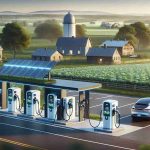- Electric vehicles (EVs) can have a larger CO2 footprint during manufacturing compared to gasoline cars.
- Government subsidies for EVs may have negative consequences, following economic critiques by experts like Adam Smith.
- Battery minerals are largely sourced from China, raising ethical and dependency concerns.
- Safety issues, including battery explosions, cast doubt on EV reliability.
- California struggles with charging infrastructure, despite government pledges for improvement.
- Many EVs are powered by electricity from non-renewable sources, conflicting with eco-friendly goals.
- There is a need for critical evaluation of EVs versus alternative solutions in the pursuit of sustainability.
In a world that champions sustainability, the rise of electric vehicles (EVs) sparks heated debate. Critics, drawing wisdom from economic stalwarts like Adam Smith and Milton Friedman, argue that government subsidies for EVs might be more harmful than helpful.
The reality? Manufacturing an electric vehicle may produce a larger CO2 footprint than traditional gasoline cars. Despite the allure of rebates and tax credits, EVs remain pricier and are often supported by questionable means. Not to mention, the crucial minerals for their batteries are predominantly sourced from Communist China, raising concerns about ethics and dependency.
Incidents of battery-related explosions and fires further fuel skepticism about their safety. On top of that, California, a supposed leader in green initiatives, struggles with an inadequate charging infrastructure. Although the Biden administration pledged billions for charging stations, progress has been painfully slow, with only a handful being set up.
The truth is, the electricity powering these vehicles often comes from non-renewable sources like coal and natural gas—contradicting the very essence of going green.
As the conversation around EVs evolves, it’s vital to question whether they deliver on their promises or if alternative solutions deserve our focus.
The key takeaway: While electric vehicles present a vision of an eco-friendly future, understanding the broader implications and challenges is crucial before fully buying into the dream. The journey towards sustainability might be more complex than it appears.
The Hidden Truths About Electric Vehicles: Are They Really Green?
## Understanding the Complexities of Electric Vehicles
In recent years, electric vehicles (EVs) have been marketed as the solution to reducing carbon emissions and combating climate change. However, the discussion surrounding their environmental impact and economic viability is nuanced. Here we explore new insights, trends, and critical questions about EVs in light of recent developments.
1. Manufacturing Footprint
Insight: A 2022 study from the International Council on Clean Transportation (ICCT) revealed that the production of EVs, particularly the battery components, can emit 68% more greenhouse gases compared to conventional vehicles over their lifecycle. The positive impact of EVs on CO2 emissions is only realized after several years of use when they replace traditional vehicles.
2. Supply Chain Concerns
Trend: The reliance on rare minerals for EV batteries has sparked interest in alternative battery technologies, such as solid-state batteries and sodium-ion batteries. These alternatives can potentially reduce dependence on unethical supply chains that lead to environmental degradation and poor labor practices.
3. Technological Innovations
Features: Recent advancements include the development of ultra-fast charging stations capable of adding 100 miles of range in just five minutes. Companies are also working on wireless charging technologies, which may eliminate the hassle of plugging in vehicles altogether.
4. Economic Viability
Market Analysis: A report from BloombergNEF predicts that by 2030, EVs will make up over 50% of new car sales globally. However, the upfront cost remains a barrier for many consumers, despite incentives. Innovative financing options, such as subscriptions or leasing models, may mitigate this issue and expand access.
Frequently Asked Questions
Q1: What are the main advantages of electric vehicles?
A1: The primary advantages of electric vehicles include lower operating costs, reduced emissions when charged from renewable sources, and potential eligibility for government incentives. They also offer a quieter driving experience and are subject to fewer maintenance needs compared to gas engines.
Q2: What are the safety concerns related to electric vehicle batteries?
A2: Safety concerns primarily revolve around lithium-ion batteries, which can catch fire or explode if damaged or improperly manufactured. However, manufacturers are continuously working on enhancing battery safety protocols and designs to address these issues.
Q3: How does the charging infrastructure affect EV adoption?
A3: An adequate charging infrastructure is critical for widespread EV adoption. Currently, charging stations are often insufficient in many regions, creating “range anxiety” for potential EV owners. Investment and expansion of charging networks will be necessary to promote the transition to electric vehicles.
Possible Limitations
While electric vehicles offer significant benefits, there are limitations to consider, including:
– Initial Cost: Despite decreasing prices, EVs still tend to be more expensive than their gasoline counterparts, making them less accessible.
– Battery Longevity: The lifespan of batteries and their recycling is still a developing area that raises sustainability concerns.
– Infrastructure: As highlighted, charging stations are not yet universally available, especially in rural areas.
Conclusion and Future Predictions
The future of electric vehicles remains bright but complex. As technology advances and society places greater emphasis on sustainability, it’s plausible to expect continued shifts in the automotive industry. Adaptations in manufacturing practices, battery technologies, and infrastructure improvements will be critical.
For those looking deeper into the discussion and developments within the EV market, visit electrive.com for the latest news and insights.



















